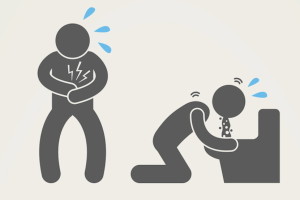
Its tough to know who is to blame for the cases of food poisoning… is it our fault or is there a higher power behind everything that is held responsible. Its debatable.
Remember back to a time, you didn’t feel so well. No, not when your significant other broke your heart, think of a unpleasant moments when your bum was planted on the toilet. It was the weekend after a night out of eating a dinner cooked by yours truly, or even if you went out to eat that weekend, you got yourself in a sticky predicament now. You’re another lucky one who got the case of food poisoning.
Everyone has gotten food poisoning before, but no one ever thinks to blame the government agencies or food production companies for it. You just had to be the unlucky one of the group again. You didn’t clean your food. Yeah, its your fault. However, what if the meal was cooked perfectly by you, and no matter what you end up doing, your body seems to be upset with you. Trace this meal back to its original traces, and ask yourself if you are to be blamed again. Let me answer this question for you. The answer is NO, you as the consumer should not be blamed for something you bought that you don’t even know yourself the full extent and full description of where and how your food has been raised. Who should be liable instead are the government agencies in charge of the food industries.
This topic has been resurfaced many times in recent news in cases like Chipotle, where they claim to have ethically raised poultry and non- Genetically Modified Foods (GMO). According to the Center for Disease and Control ( CDC), as of January 27, 2016 there was a total case of 55 people who were infected with the outbreak strain of Escherichia coli ( E. Coli) O26 in Chipotle restaurants; for those who may not be aware of the symptoms from this strain, symptoms include bloody diarrhea, and for extreme cases, kidney failure. As a popular food chain, they took actions immediately to expand the testing of fresh produce, raw meat and diary items prior to restocking the restaurants. Luckily they are taking the next step in making their food safer for the consumer. Other cases haven’t been so generous in doing it for the people, rather than keeping the company name safe. They will fight to keep doing what they are doing and that is keeping the consumer clueless as to where the food they put in their mouth has been and has gone through.
In documentary films like Food Inc, they expose different cases in which food has been a big issue in people’s lives. One of the big cases that was mentioned was Kevin’s story. Kevin was described to be a little boy who was full of life and on one family vacation decided to chow down on a burger during some of his meals. Note, that he was not the only one eating the burgers and his mother, father, and sister were also along side him on this vacation, also eating the same burger from the same company that were all cooked the same way. After returning home from his retreat, Kevin’s mother reported seeing blood in Kevin’s stool and also noticed that he was accumulating a slight fever. They headed to the doctors but were sent home. The next day, Kevin’s condition was significantly worse that it had ever been and they went to the hospital again for bloody stools again, and also dehydration. His kidneys started to fail, and they were given the diagnosis that he had contracted E. coli O157:H7. He passed away shortly after. Kevin’s sister and father were also tested positive for E. coli O157:H7, but cases were both less extreme than those of Kevin’s. They brought this case to court, but were told they they did not have enough evidence. Later on, the same company had done a random test on their meats, and were positive for E. coli O157:H7 and the PFGE pattern (for DNA) for Kevin’s E. Coli matched the PFGE pattern of the recalled meal. However this was still not enough evidence o get justice for Kevin. What happened to Kevin was very tragic, and scary. But the scariest thing is that this situation can happen to anyone, despite eating meat or vegetables. No one is safe.

Kevin’s story was very heart breaking to hear, but as mentioned before his sister and his father who also ate the contaminated food just had one uncomfortable bowel movement. This seems to be very common where food poisoning gives people the results of just an uncomfortable bowel movement. So common, that when it happens, people brush it off their shoulders and move on with their day. The most frequent cases of these illnesses are viruses and species of bacteria, but most episodes are never even reported to authorities. According to Resisting Food Safety, Marion Nestle mentions that the most authoritative estimate of the yearly number of cases of food borne disease in the United States is 76 million illnesses, 325,000 hospitalizations, and 5,000 deaths. Today, Food Production has created more promising conditions for bacteria and viruses to breed. Infected animals excrete pathogens in their feces, and other animals and plants come across the infected feces and then we proceed to eat it. Some of the pathogens survive cooking, stomach acid and other bodily functions and these pathogens can multiply and do much worse things to your body. On top of these pathogens, plants are genetically modified and animals are even fed ridiculous foods, both are done in effort to make the food bigger and more appealing to the consumer.

When you first lay your eyes on a fat cow, you immediately think that this cow was fed proper meals and was grown to be big, fat, and healthy. You would also imagine this cow hanging out with other fat cows on nice big grass fields and eating grass like they do in commercials and cartoons. However this is certainly not the case. According to You Are What They Eat by Consumer Reports, cows are fed things as ludicrous as chicken feathers, because they apparently contain a high source of protein. On top of that, all of the animals, including cows, chickens, pigs and even fish are fed corn. Corn comes in abundance, and fattens up the animal quick. Corn, is also very cheap to produce and harvest and distribute. As casual as that sounds, lets backtrack for a bit. Cows are fed corn, when they are supposed to be eating grass. Cows are unable to digest corn. When they eat corn, it can upset their digestive system. According to an online piece of writing titled What Happens in the Stomach of Corn-fed Cows, the author Laurel gives detail on what exactly happens to a cow when they consume corn. Cattle create a lot of gas, which they usually release, but when their diet is high in starch and low in roughage, a layer of foamy slime forms in their great food-processing tank. This reading states that a corn diet can also generate acidosis. Unlike our highly acidic stomachs, the normal pH of cattle stomach is neutral. Corn makes them unnaturally acidic. Acidotic animals go off their feed, pant, and drool, paw at their bellies and eat dirt. This condition can lead to diarrhea, ulcers, bloating, liver disease and general weakening of the immune system. A cow that has a poor immune system due to eating corn, which was intentionally meant to make them fat and appealing, is being served to us. The extent to which the negative affects of the cow eating corn that can be passed onto humans through consumption are still unknown, but it surely does not sound appealing. If you want to see a disturbing image of a cows stomach and the slimy foam that layers in their stomach go to 00:22:46 in the documentary film Food Inc, currently playing on Netflix.
Some people argue that organically grown foods are healthier. Considering they don’t feed their animals ridiculous foods such as corn. Corn is only an option because it is so cheap and easy to make. This makes it very easy for big companies to make lots of money. As opposed to organic food, where cows are free to roam and eat grass, like they were destined to, and they live on a land where farmers do not have to stick their hands inside of their stomach to clear out nasty slimy foam. All in all, this argument is that organic food is better food. However, Blake Hurst, the writing of Organic Illusions, he opposes this idea that organic is the better option. He also mentions that the cases of E. Coli were also present in organic foods, so food being organic does not eliminate the fact that E. Coli is still around. He mentions a lot of points that big production companies will provide more jobs if the food was not organic. However, according to Food Inc, it is true that big production companies hire a lot of people to work for them, thus always having job openings. They tend to hire undocumented workers so they are able to hire more workers, but also pay them very little and they have no employee benefits. Also, lets not forget they are undocumented, meaning they can easily be thrown back to where they came from, and the big production company that hired them will stay in the shadows as they are the day they hired these workers. So is it true that big production companies will provide more jobs for people. Yes, that is true. This doesn’t change the fact that E. Coli still exists, and big production companies are doing what they do best, and that is staying in the shadows.
Despite obvious concerns of the food industry and the impacts it has on our health, food industries are doing little to mother about it. We are left with a constant mystery of where our food has been. You might as well be blind folded for every meal. We need to hear the truth, and we want justice for all the cases of E. Coli around the nation.
Reflection Questions:
- My understanding of the writers project was to break down each of the texts and pick out information that I would use to defend my own project. Many of the articles that I broke down had different topics mentioned, but under the big umbrella of food poisoning. My main project was to inform the consumers of the secrets the food production companies are hiding from us. I use graphic information as well as sad ones too to try to engage the reader.
- I personally, did not enjoy sorting it out. I feel as though it did not really help. However, the section where I needed to connect everything together was the most helpful of all the parts. I made most of my connections to Food Inc since Food Inc was the one thing we looked at that talked about everything. Other than that, I didn’t use everything on the sorting it out workshop, I personally found it a little confusing and I did not enjoy filling it out.
- Synthesizing is when you combine ideas from others to form your own argument. Synthesizing helped me form my argument as well as provide evidence for some parts of my paper. It made my writing more reliable and that I was not making up the information.
- I would say this blog post is an accomplishment. I never made a blog post like this before, and it was fun to go through drafts and go through other peoples writings and finally make this end product of a blog post and also just learning how to connect many articles together in one writing.
- To create my main idea, I picked out one broad topic and narrowed it down. I also wanted it to connect to the people so that when someone reads it, they are engaged and feel like this problem can also affect them, and that the food production companies will look over each and every person and not give the justice each person deserves.
- I am not proud of my first couple drafts. But I used it to just bunch all the texts together and as I kept writing more drafts I added more to try to engage the readers. I transitioned from trying to capture the reader with a personal story, to talking about Kevin and his tragic story for an emotional appeal. Then I get scientific and give details on where some of our meat, mostly beef since thats what Kevin ate before dying. I tried to make this a persuasive piece.
- I synthesized Nestle, Food Inc, Consumer reports together and I used Hurst’s writing as a bit of a rebuttal. This evolved as I was writing the texts, since now I incorporate the evidence into the texts instead of just repeating what they said. I am able to easily connect all of the texts together.
- For the lede, I just tried to capture the reader as best as I could by using a fake, but totally real, scenario. The feedback that I received was that she was “tempted to keep reading because seeing relevant topics such as Chipotle makes me interested and i also agree with how it is not the consumers fault and would like to hear more about what you have to say”. I used this information to try to make more relatable cases for the reader to engage the reader more.
- Overall, I want to be better at synthesizing. I want my writing to have a better flow and to engage more readers into my writing.






